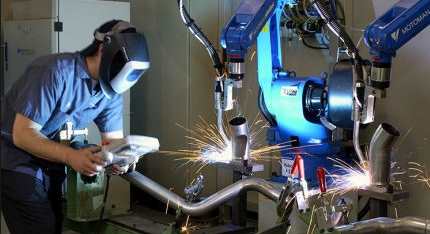Robotic Welding: Understanding the Advantages

In the simplest of terms, welding is the joining of two materials. Welding is a necessity in most industrial processes, but especially in these three industries.
- The automotive industry.
- High production manufacturing.
- The construction industry.
Over the years, thanks to technological advancements, robots have taken over welding in most industries. Collaborative robots especially have allowed robots to be adopted in even more welding applications.
A welding collaborative robot arm has a lot of benefits. We will analyze these advantages in depth as a way of helping you understand that no matter the size of your enterprise or rate of production, welding robots are bound to add value.
Uniform and High-Quality Welds
When you look at an impressive skyscraper, welding is not the first thing that comes to mind. The truth, however, is that a lot of high-quality welding happened behind the scenes. Otherwise, the skyscraper would fall apart.
This kind of high-quality welding depends on two factors: the material used and the consistency of the weld. Robotic welding guarantees consistency. A well-programmed welding robot is consistent and it produces the exact kind of high-quality weld it was programmed for.
Additionally, the weld is uniform across the different components. A human, on the other hand, cannot maintain precise uniformity across various welds.
Increased Productivity and Returns
First, a welding robot can be set to work a 24-hour day for seven days of the week. A human being only works for eight hours a day and five days a week. An increase of more than a hundred productive hours makes a lot of difference in terms of the final yield of a product per set time limit, the returns and productivity.
Productivity and returns are determined by how much of the complete product is ready for market after a given period of time. If in month X complete products number 50 and in month Y they number 100, then it follows that the productivity of month Y is higher and the returns after the sale will be higher as well.
Second, a welding robot is considerably faster than a human professional. Again, speed affects the production rate.
Reduced Waste and Better Use of Materials
A key feature of any robot is that they are almost error free. A welding robot does exactly what it was programmed to do over and over again with minimal errors. A human professional can have off days or get tired and produce bad work which then has to be discarded.
A simple human error is also common and frequent. No matter how careful the welder is, chances for errors are always high. Think of a car for instance. A lot of welding happens to ensure the body of the car is seamless and appears as almost one entity. During the welding process, a professional can weld at the wrong angle unknowingly.
These discards add up to a lot of wasted material and this ends up being expensive for the manufacturer. A welding robot will find the best way to use the material as a way of reducing wastage and the few errors guarantee the discards are negligible.
What You Should Take Away from This List of Benefits
First, it is important to note that the benefits of robotic welding are more than the three discussed. Less work, for instance, or reduced cleaning after welding because the wastage is so little. Depending on your industry and how you implement the welding robot, advantages can always be more.
However, there is one major takeaway. That a welding robot is an employee who is faster, works for longer hours, has negligible errors and uses up all the material in the best way possible. Hiring such an employee immediately is prudent because they will help you compete with bigger and more established businesses.
Summed up, if your business is heavily reliant on welding then a welding robot is a necessity.







